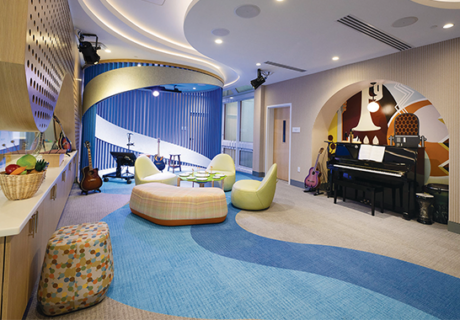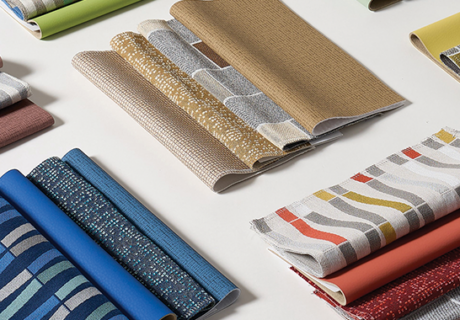Delivering Wellness And Community At St. Jude’s Family Commons
Read “IIDA Announces 2023 Healthcare Design Awards Winners” for more on St. Jude Children’s Research Hospital
St. Jude Children’s Research Hospital in Memphis, Tenn., treats childhood cancer, sickle cell disease, and other life-threatening disorders. Patients and families receiving treatment often live in off-campus housing provided by St. Jude during treatment—sometimes for weeks or months at a time.
Recognizing this situation, St. Jude offers services for family that go beyond traditional healthcare needs, such as a pharmacy or medical supply pick-up, to include a post office and bank as well as respite and activity spaces on campus.
To consolidate those services into one location to make them easier for families to access, the organization turned a vacant inpatient floor on its campus into a treatment- and clinical-staff-free zone.
Opened this past February, the 45,000-square-foot Family Commons houses a variety of spaces, including pre-K to high school classrooms with a science lab and library, reading alcoves and resting nooks, a music room with a recording studio, maker space, hair salon, indoor and outdoor play areas, café with coffee and snacks, and centralized patient and housing services.
Here, David Taglione, design director at ICrave (New York), which delivered the interior design, experience design, and lighting design on the project, talks about translating design goals into the physical environment at Family Commons as well as using inclusive design strategies to appeal to a broad range of patients and family. (For more on the Family Commons project, click here.
Healthcare Design: When you first got involved with the Family Commons project, what design directive or goals did St. Jude give you?
David Taglione: Our ICrave team worked closely with actress Marlo Thomas, who is the daughter of Danny Thomas, the late St. Jude founder, as well as St. Jude’s president, Dr. James Downing, to develop each of the design concepts and align on the direction.
From the very beginning, St. Jude was clear about wanting this space to be dedicated entirely to patients and their families—something unique within the existing infrastructure on the St. Jude campus.
They wanted to create an intimate community experience, where patients and caregivers can share experiences and build connections to others going through similar struggles and find moments of normalcy and joy.
We sought out to reimagine what patients, families, and caregivers could experience and accomplish within the new facility, posing questions such as “How can we create a space that invites families to feel right at home?” and “How can we design meaningful touchpoints that invite discovery and create a layered experience that evolves?”
How did you translate that design intent into the physical environment?
The design of Family Commons is meant to reflect moments and activities that are part of life outside of treatment. This includes activities like making music and art, doing a fun science experiment, or getting your nails and hair done stylishly at the salon.
This place is meant to bring back the little things in life that fall to the wayside when you’re sick, making lost experiences accessible and encouraging patients and families to indulge in them.
Bright colors and uplifting tones are found throughout, and many areas have been transformed into familiar objects found in nature. Examples include large tree trunk nooks where kids can hide or have quiet time, and ceiling light fixtures in the shape of clouds.
Special attention was paid to spaces like the salon, infusing the area with bright colors and warm woods, creating an environment that offers a playful escape for patients who may be going through the challenging experience of hair loss.
How is Family Commons designed to be interactive?
There are many digital, engaging elements. For example, in the Music Room, we incorporated the latest LED technology to design a perforated wall system with innovative, sound-activated colored backlighting. The wall follows the musical notes playing in the room and creates a playful experience by activating a light show that runs through a custom perforation design.
The facility has a school with classrooms catering to multiple grade levels, from Pre-K and kindergarten to high school, fostering diverse learning experiences and promoting interaction, community, and collaboration. The design includes layouts that encourage group learning and quieter spaces for one-on-one or solo time.
Our design team thoughtfully blended physical play with discoverable elements, too. Patients can have fun counting clouds or finding hidden surprises, making the space engaging and encouraging them to explore.
How did you utilize inclusive design to appeal to patients of all ages?
The project’s scalability is noteworthy, as it caters to different heights and abilities. Layered graphic murals offer beautiful visuals as an inclusive experience.
In the art room, you will find a custom-designed balloon ceiling, a novel concept adding a touch of magic to the space. Drawing inspiration from the simple yet beloved “stick drawing” house shape, the project brings those illustrations to life in a three-dimensional and interactive manner. This creative twist on a familiar form appeals to children’s imagination and comfort.
Inclusive design is evident in the thoughtful selection of furniture of varying scales and sizes, too, ensuring comfort for individuals of all ages and abilities. Flexible seating arrangements accommodate different group sizes, enabling intimate conversations and larger gatherings.
Safety was also a crucial consideration in the design of the play spaces. Recognizing that falls can be particularly dangerous for certain patients, we incorporated appropriate heights and safety measures while still creating exciting and enjoyable areas, enabling children to explore and engage in play without compromising their well-being.
What was the biggest challenge in renovating a former inpatient floor into the Family Commons?
In this instance, the project site was fully cleared of its former inpatient use, so we had the opportunity to work from a blank slate. The challenge was truly about changing our ways of thinking about non-clinical spaces, which opened our minds to new design opportunities.
St. Jude’s commitment to dedicating so much space to patient wellness was inspiring and an incredible design thesis for our team to explore.
By shifting focus away from strictly functional environments in traditional healthcare settings, we were able to explore multiple approaches to enhance the patient experience. So the building provides both relief for stress and anxiety while offering the chance for discovery and delight.
How did you choose materials and construction methods for Family Commons?
Priority was given to infection control, ensuring a safe and secure environment. Soft fabrics and other typical cozy elements were not possible with this in mind. Our team had to be creative with whimsical color palettes and soft edges to create warm and inviting spaces.
Working closely with St. Jude, our team of designers tapped into the power of aesthetics, incorporating natural light, flexible spaces, and playful furniture, thereby transforming a healthcare facility into an environment that promotes healing, discovery, and rejuvenation.
(For more on St. Jude Children’s Research Hospital, go here.)
Anne DiNardo is executive editor of Healthcare Design magazine. She can be reached at anne.dinardo@emeraldx.com.



